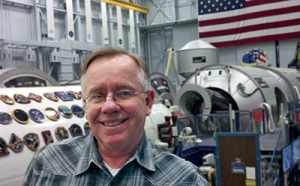On Christmas Eve 2013, as children around the world were nestled snug in their beds waiting for Santa Claus, NASA astronauts Rick Mastracchio and Mike Hopkins suited up and prepared for an Extra-Vehicular Activity (EVA) — or spacewalk — to repair the International Space Station’s orbiting outpost’s critical external cooling system.

It was the second in a series of spacewalks quickly planned after the space station’s starboard cooling pump developed problems. Back on Earth at NASA’s Mission Control Center, Randall Owen was closely monitoring the health of the astronauts. With so much on the line, stress and fatigue could spell disaster for the mission. “We use an electrocardiogram to check for problems with the electrical activity of their heart and observe their vital signs for up to eight hours at a time,” he says.
When orbiting at a height of 230 miles above the earth’s surface at a speed of more than 17,000 miles per hour, calling for an ambulance during an emergency isn’t in the cards. Enter Owen, M.S.H.S., PA-C ’13, a medical operations specialist in space flight operations at NASA’s Johnson Space Center (JSC) in Houston, Texas. Owen trains International Space Station (ISS) operations crew members to be their own first responders, teaching them to perform in-flight medical procedures, such as phlebotomy and ocular exams, as well as respond to emergencies such as broken legs or heart attacks.
Owen, a graduate of GW’s School of Medicine and Health Sciences (SMHS) Physician Assistant Program, landed at NASA in April 2014. He was the first PA student to complete a four-week clerkship in aerospace medicine at the JSC.
The clerkship, which historically has been offered only to fourth-year medical students, gives participants the chance to work on an aerospace medicine project, attend lectures, and become familiar with the medical aspects of ISS operations, design, and function.
Participants in the clerkship are required to complete a research project based on an area of space medicine. Owen focused his research on Entry Motion Sickness (EMS), which astronauts often experience when returning from the microgravity environment of space to Earth’s one G-force atmosphere. The longer astronauts are away from Earth’s gravitational field, the more time it takes for them to return to normal, explains Owen, whose research showed that “for three- to six-month missions, the EMS symptoms seem to require a minimum of a few days to up to 30 days to fully resolve.”
A Southern California native, Owen was the only one of six siblings to attend college. Prior to earning his bachelor’s degree in physics at the University of Texas at Dallas, Owen served in the United States Air Force and Air National Guard for eight years. It was there, Owen explains, that his interest in aerospace medicine really took flight.
Orbiting at a height of 230 miles above the earth’s surface at a speed of more than 17,000 miles per hour, calling for an ambulance during an emergency isn’t in the cards.
An engineer and project manager for more than 20 years, Owen fell victim to the recession. In 2009, after being laid off for a fourth time in nine years, he decided to change career paths completely.
“I had always been interested in medicine and had briefly considered medical school,” he says. “But at my age, four years of medical school followed by a three- to five-year residency just didn’t seem practical.” So Owen enrolled in a full-time, one-year course to become a certified surgical technologist while taking prerequisite courses for PA school in the evenings.
Owen arrived at GW in May 2011. “I knew I was embarking on a life-changing journey in the company of an amazing group of students and faculty,” Owen says. The PA program at SMHS offered the academic rigor Owen was looking for in his training. At the same time, he was able to explore areas of medicine through the program’s elective clinical rotations.
It was the mentorship and support of Debra Herrmann, M.S., assistant professor of Physician Assistant studies at SMHS, that helped Owen reach his goal of supporting the health of crew members aboard the ISS. Herrmann says she found Owen’s professionalism, maturity, and real-world experiences extremely valuable when discussing complex issues in patient care. “We all benefited from his perspectives,” says Herrmann, who is extremely proud of Owen for representing SMHS’ PA program and the profession at NASA.
The sky is the limit for Owen, who is currently focused on establishing educational and employment paths for PAs interested in aerospace medicine. “I hope to identify clinical and non-clinical employment opportunities within both the government and commercial segments, such as NASA, SpaceX, and Orbital Sciences,” he explains.
For Owen, his experiences at GW, especially through the public service examples set by the PA faculty, “have made all of this possible.”



